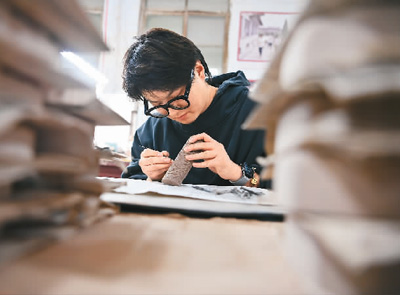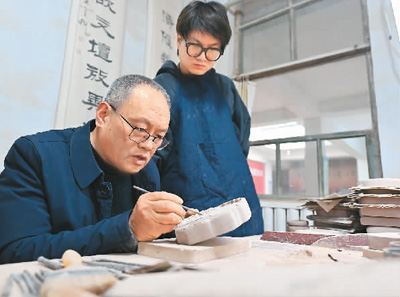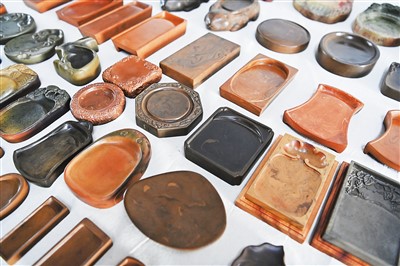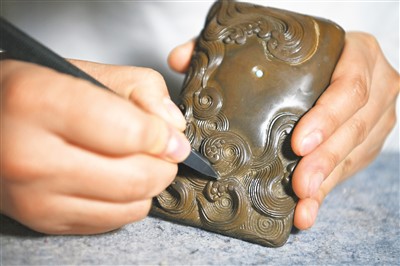Three generations commit to making Chengni inkstone in N China's Shanxi
Lin Xiaolin is the third-generation inheritor of the craft of making Chengni inkstone, which has been listed as one of China's national intangible cultural heritages, in north China's Shanxi Province.

Lin Xiaolin carves on a Chengni inkstone in north China's Shanxi Province. (Xinhua/Yang Chenguang)
Chengni inkstone, one of the "four famous inkstones" in the country, is known for its fine texture which can reduce wear and tear to the brush. With a history of over 1,000 years, the craft had once been lost for hundreds of years and was later brought back by Lin Xiaolin's grandfather Lin Yongmao and father Lin Tao.
It takes nearly a year and more than 10 steps to make a Chengni inkstone. Lin Xiaolin knew the craft since his childhood.
In 2011, he studied abroad, focusing on modern ceramic technologies. He returned to China after graduating from college in 2019, hoping to create more diversified Chengni inkstones by combining modern technologies with traditional design.
The first set of Chengni inkstones Lin Xiaolin produced after he returned to China won a gold prize at the Shanxi Cultural Industries Fair, while another set won a bronze prize at the fair.
During a session of a TV program themed on China's intangible cultural heritage, Shan Jixiang, a former curator of the Palace Museum, praised a sage green inkstone made by Lin Xiaolin.
"My grandfather and father spent over 30 years trying to make sage green inkstones. These years, they only succeeded in producing three to four sage green inkstones," he said.

Lin Tao (left), a representative inheritor of the craft of making Chengni inkstones at the provincial level, guides his son Lin Xiaolin on the details of carving on Chengni inkstones in north China's Shanxi Province. (Xinhua/Yang Chenguang)
Following in their footsteps, Lin Xiaolin succeeded in making over 20 sage green inkstones in one kiln this year.
He has strived for excellence in the research and development of Chengni inkstones these past years. In 2020, a set of inkstones he designed won a gold prize at the first arts and crafts expo of Shanxi. Another of his inkstones won a bronze prize at an innovative product design competition a year later, and a grand award at the Xinjiang cultural and tourism trade fair in northwest China's Xinjiang Uygur Autonomous Region in 2023.
In Lin Xiaolin's view, traditional Chengni inkstones were mainly used as collectibles as they were produced in small quantities and sold at high prices. To bring Chengni inkstones to ordinary Chinese families, innovations in product categories should be made to make them better cater to contemporary aesthetics and needs.
Lin Xiaolin established a team to design and develop cultural and creative products for Chengni inkstone.
He runs an online store, introducing the history, culture and techniques of making Chengni inkstones through livestreams.
"We want people to not only learn about the material selection and carving process, as well as the difficulty of firing and making a Chengni inkstone, but also enhance their appreciation of Chengni inkstones. More profoundly, we hope that more people can understand the spirit of craftsmanship behind the craft," he said.

Photo shows Chengni inkstones. (Xinhua/Yang Chenguang)
Lin Xiaolin also adds more modern fashion elements to his Chengni inkstone products, making them functional yet decorative, and well-received by young people. He increases the colors of Chengni inkstones by controlling the temperature of the kiln.
"Our team continues to innovate and launch products with ‘wow’ factors, hoping to let more young people understand and love Chengni inkstones," Lin Xiaolin said.
He also rolls out peripheral products related to Chengni inkstones to better meet the young people's aesthetic tastes, including ornaments and seals.
Lin Xiaolin has been awarded many honorary titles, including a representative inheritor of the craft of making Chengni inkstones at the municipal level.

Lin Xiaolin carves on a Chengni inkstone in north China's Shanxi Province. (Xinhua/Yang Chenguang)
Photos
Related Stories
- Pic story of inheritor of Yellow River Chengni inkstone in Henan
- Three generations of a family in N China's Shanxi revive Chengni inkstone
- Stone carving master in China’s Shandong devoted to developing local inkstone craft
- County in N China’s Shanxi province helps improve villagers’ life through traditional cultural industries
Copyright © 2023 People's Daily Online. All Rights Reserved.









